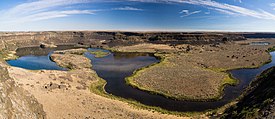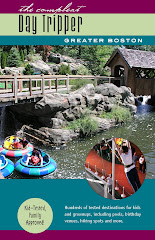
Saturday, July 25, 2009
Lake Lenore Caves in the Coulee Corridor

Dry Falls and the Coulee Corridor
 Warning: Fun Science Alert! When the Ice Age was on, there was a huge lobe of glacial ice that extended down into Central Washington, called the Okanogan Lobe, which diverted the course of the Columbia River. In the meantime, there was another huge lobe of glacial ice that blocked off the drainage of the Clark Fork, Spokane, Pend Oreille, and St. Joe Rivers and formed a huge lake in Montana called Glacial Lake Missoula. When all that water backed up in the Rockies busted loose, it came raging down the foothills and slammed into the Okanogan Ice Lobe and went sluicing down the diverted course of the Columbia which we commonly know as Sun Lakes Coulee. (Officially Lower Grand Coulee) As the water came rushing through it carved a "coulee" or valley right down through the layers of basalt rock and left a rather dramatic dry waterfall, once ten times the size of Niagara Falls, with beautiful Dry Falls Lake at its base, which is the first lake in the Sun Lakes chain.
Warning: Fun Science Alert! When the Ice Age was on, there was a huge lobe of glacial ice that extended down into Central Washington, called the Okanogan Lobe, which diverted the course of the Columbia River. In the meantime, there was another huge lobe of glacial ice that blocked off the drainage of the Clark Fork, Spokane, Pend Oreille, and St. Joe Rivers and formed a huge lake in Montana called Glacial Lake Missoula. When all that water backed up in the Rockies busted loose, it came raging down the foothills and slammed into the Okanogan Ice Lobe and went sluicing down the diverted course of the Columbia which we commonly know as Sun Lakes Coulee. (Officially Lower Grand Coulee) As the water came rushing through it carved a "coulee" or valley right down through the layers of basalt rock and left a rather dramatic dry waterfall, once ten times the size of Niagara Falls, with beautiful Dry Falls Lake at its base, which is the first lake in the Sun Lakes chain. About 100 miles west of Spokane on Highway 2, turn south on Highway 17 which runs right down through the coulee. The first point of interest you will come to on this leg of the journey is the Dry Falls Overlook & Interpretive Center. This is a great place to introduce your kids to the concepts of climate cycles and the awesome power of nature. Another thing to marvel at here, is the beautiful rock masonry structures built by the Civilian Conservation Corps in the 1930's. There were some tremendous craftsmen on those crews.The Interpretive Center is open from 9 a.m. to 4 p.m. daily, except holidays, and they have restrooms.
Sun Lakes State Park in the Coulee Corridor
 Fancy some traditional recreation after your geology lesson? As you leave Dry Falls Interpretive Center going south on Highway 17, you will descend down into the coulee. On the right in the layers of basalt, you can see a fault line where tectonic plate movement is apparent. On the left you will see a golf course, campground and park at the north end of Park Lake. There is also miniature golf (a really nice new installation terraced on the hillside), paddle boat rentals, snack bar, gift shop, swimming, docks, fishing, cabins, and all kinds of fun stuff. The Ping family has been operating this park concession for a number of years, and has made many improvements.
Fancy some traditional recreation after your geology lesson? As you leave Dry Falls Interpretive Center going south on Highway 17, you will descend down into the coulee. On the right in the layers of basalt, you can see a fault line where tectonic plate movement is apparent. On the left you will see a golf course, campground and park at the north end of Park Lake. There is also miniature golf (a really nice new installation terraced on the hillside), paddle boat rentals, snack bar, gift shop, swimming, docks, fishing, cabins, and all kinds of fun stuff. The Ping family has been operating this park concession for a number of years, and has made many improvements.
Blue Lake Rhino in the Coulee Corridor
 As you continue south on Highway 17 from Sun Lakes State Park, through the majestic Lower Grand Coulee, you will come to a small, unassuming, resort called Laurent's Sun Village Resort. You can rent rowboats at this resort and the most remarkable thing is that just across the lake there is a small cave that was actually formed by the body of a prehistoric rhinoceros that was caught up in a lava flood when all this basalt rock was laid down during late Miocene and early Pliocene times (between 17 and 6 million years ago). Be sure to bring a flashlight and be ready to crawl into the tight cave.
As you continue south on Highway 17 from Sun Lakes State Park, through the majestic Lower Grand Coulee, you will come to a small, unassuming, resort called Laurent's Sun Village Resort. You can rent rowboats at this resort and the most remarkable thing is that just across the lake there is a small cave that was actually formed by the body of a prehistoric rhinoceros that was caught up in a lava flood when all this basalt rock was laid down during late Miocene and early Pliocene times (between 17 and 6 million years ago). Be sure to bring a flashlight and be ready to crawl into the tight cave. If spelunking in small caves isn't your cup of tea, I suggest renting the rowboat, check out the cave from the outside and then take the kids over to Seattle to the Burke Museum where they have made a full size mock up of the cave from plaster casts and have a nice educational display about it. Laurent's also has a miniature golf course, park, camping, cabins, and fishing opportunities. To learn more about the lava floods check out the USGS website.
Good Clean Fun at Soap Lake
.jpg) With a mineral content similar to the famed spa at Baden-Baden, Germany, Soap Lake has long attracted health-seeking visitors from all over the world. A gathering point for the Columbia Plateau tribes before white settlers came to Washington, the Native Americans called it Smokiam, or "Healing Waters." After World War I, the victims of mustard gas attacks developed a disease called Buerger's Disease, and Soap Lake water was the only known cure. A sanitarium was built to treat the afflicted soldiers.
With a mineral content similar to the famed spa at Baden-Baden, Germany, Soap Lake has long attracted health-seeking visitors from all over the world. A gathering point for the Columbia Plateau tribes before white settlers came to Washington, the Native Americans called it Smokiam, or "Healing Waters." After World War I, the victims of mustard gas attacks developed a disease called Buerger's Disease, and Soap Lake water was the only known cure. A sanitarium was built to treat the afflicted soldiers.The water is too alkaline to support piscine life, so leave your fishing pole in the car, lest you make a spectacle of yourself. (I have friends that "go fishing" there just to be funny). Brine shrimp and a few water bugs inhabit the water. Some of the locals will attempt to intrigue you with tales of a lake monster, but they are just pulling your leg.
Soap Lake boasts several gradually sloping beaches that make it very safe for little ones to play in the lake. And, because the water is so dense, it is virtually impossible to sink. You can float around all day with your head, hands and feet sticking out of the water (try that in normal water and you sink like a stone). When you come out, the minerals from the lake will dry in white water spots on your skin. There are showers on the developed beaches where you can rinse off if you like.
Another interesting thing about Soap Lake is: when the wind blows, the wave action on the shore actually whips up suds (see photo)! Soap Lake is at the south end of the Coulee Corridor at the junction of Highway 17 and Highway 28.



